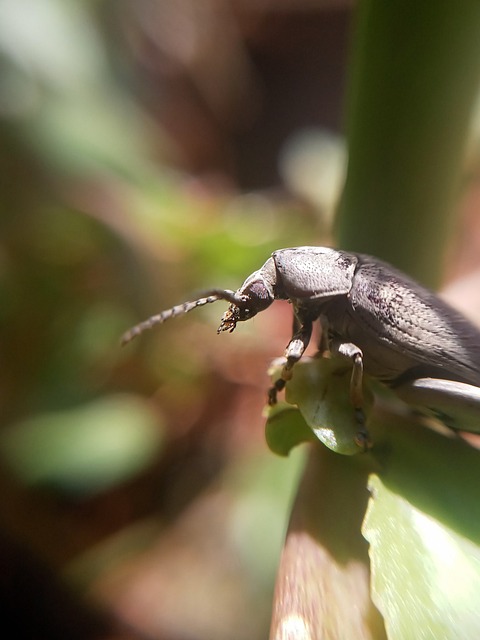Grain weevils, tiny pests measuring under 1/8 inch, threaten stored grains and dried foods. Professional services employ advanced strategies like inspections, eco-friendly treatments (e.g., IPM, biological control), and monitoring systems for effective control. Residential properties use localized pesticide applications while commercial settings require extensive strategies. Homeowners increasingly seek professional help to prevent and manage grain weevil infestations safely and sustainably. Eco-friendly solutions are favored over traditional chemical methods for their safety and environmental benefits, especially in commercial operations. Strategic multi-step approaches disrupt the weevil lifecycle, eliminate current infestations, and prevent reoccurrences for lasting protection. Preventive measures include regular inspections, sealing entry points, improved ventilation, and storing grains in airtight containers.
Grain weevils can cause significant damage to stored grains and foods, posing a major threat to homes, businesses, and agricultural operations. To effectively combat these pests, thorough inspections are crucial for identifying activity and breeding sites early on. This article delves into understanding the behavior of grain weevils, exploring traditional and eco-friendly control methods, providing strategies for residential and commercial treatment, and offering best practices for prevention. Discover professional grain weevil removal solutions and learn how to safeguard your spaces from these persistent invaders.
Understanding Grain Weevils: Behavior and Breeding Patterns
Grain weevils are a common agricultural pest known for infesting stored grains, seeds, and dried foods. Understanding their behavior and breeding patterns is crucial for effective grain weevil control services. These tiny insects, often measuring less than 1/8 inch long, prefer dark, humid environments and can breed rapidly in suitable conditions. They lay eggs in crevices and cracks within stored products, and their larvae feed on the starch in grains, causing significant damage.
Professional weevil removal experts employ various methods to detect and eliminate grain weevil infestations. These include thorough inspections to identify breeding sites, targeted treatments using eco-friendly solutions, and monitoring systems to prevent future outbreaks. In residential settings, weevil treatment involves localized applications of pesticides, while commercial weevil extermination requires more comprehensive strategies due to larger storage areas and higher pest pressure. Effective grain weevil infestation treatment demands a deep understanding of these pests’ biology and behavior, which is why many homeowners opt for professional services to ensure successful control and prevention.
Traditional vs. Eco-Friendly Grain Weevil Control Methods
In the battle against grain weevils, traditional control methods have long been the go-to solution for many businesses and homeowners. These methods often involve powerful chemicals, including insecticides, which can be effective in eliminating weevils but come with potential environmental and health concerns. However, with growing awareness of sustainable practices, there’s a shift towards eco-friendly grain weevil control services that offer both effective pest control for grain weevils and residential or commercial weevil treatment without sacrificing safety and environmental friendliness.
Professional weevil removal experts now employ innovative techniques such as integrated pest management (IPM), biological control, and natural repellents to combat these pests. These eco-friendly solutions are not only safer for people and pets but also help preserve the biodiversity of our ecosystems. For commercial operations, where grain weevil infestation treatment is crucial, eco-conscious methods can be tailored to specific needs without compromising on effectiveness, ensuring a healthier and more sustainable environment for everyone involved.
Strategies for Effective Residential and Commercial Weevil Treatment
When dealing with grain weevils, a strategic and comprehensive approach is essential for effective control. Professional weevil removal services often employ a multi-step strategy tailored to each unique infestation. This typically begins with a thorough inspection to identify the extent of the grain weevil activity and breeding sites. Once detected, residential or commercial weevil treatment can involve a combination of methods like chemical treatments, physical removal, and eco-friendly solutions.
For instance, professional pest control for grain weevils in residential areas might focus on sealing entry points, removing infested materials, and applying targeted pesticides. In commercial settings, such as warehouses or food processing facilities, the approach may be more stringent, involving heat treatment, fumigation, or advanced mechanical methods to ensure complete grain weevil extermination. The goal is to disrupt the weevil’s lifecycle, eliminate current infestations, and prevent future reoccurrences, providing long-lasting protection against these pests.
Preventing Future Infestations: Best Practices for Grain Weevil Management
Preventing future infestations starts with proactive measures to control and eliminate grain weevils. The first line of defence is regular inspections, especially in areas prone to moisture accumulation or where grains are stored for extended periods. Professional weevil removal services can conduct thorough assessments, identifying breeding sites and implementing targeted treatments. These methods often include eco-friendly solutions, ensuring minimal environmental impact while effectively managing the pest.
For effective grain weevil control, it’s crucial to address potential entry points into buildings or storage facilities. Sealing gaps and cracks, improving ventilation, and storing grains in airtight containers can significantly reduce the risk of an infestation. Commercial weevil extermination may also involve setting up monitoring systems to detect any early signs of re-infestation, allowing for swift action and preventing the widespread damage caused by these pests.
Grain weevils can cause significant damage to stored grains and food products. Regular inspections and prompt action are crucial in managing infestations. By combining traditional methods with eco-friendly solutions, such as professional weevil removal services, residential and commercial properties can effectively mitigate these pests. Implementing best practices for grain weevil management not only protects valuable resources but also ensures a safer, healthier environment. When facing a grain weevil infestation, it’s essential to seek expert advice from pest control services specializing in these specific insects to achieve successful treatment and prevent future outbreaks.
